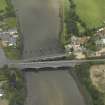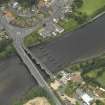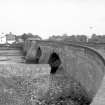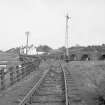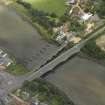Guardbridge, Guard Bridge
Road Bridge (15th Century)
Site Name Guardbridge, Guard Bridge
Classification Road Bridge (15th Century)
Alternative Name(s) River Eden; Old Guard Bridge
Canmore ID 32873
Site Number NO41NE 1
NGR NO 45188 18877
Datum OSGB36 - NGR
Permalink http://canmore.org.uk/site/32873
- Council Fife
- Parish Leuchars
- Former Region Fife
- Former District North East Fife
- Former County Fife
NO41NE 1 45188 18877
(NO 4519 1887) Guard Bridge (NR)
OS 6" map (1938).
For (successor) new and railway bridges (both adjacent to N), see NO41NE 44 and NO41NE 61 respectively.
'Guard Bridge. This fine mediaeval bridge crosses the River Eden 3 1/2 miles west of St Andrews. "Guard" is a corruption of the real name of the bridge which, as 'Legare (lie gare) brig' was built 'at great expense' by Bishop Wardlaw of St Andrews (1404-40). As 'the Gair Bridge' it was among those to be repaired in 1685 from the revenues of 'vacant stipends' (Acts Parl Scot).
The bridge has six, arches all unribbed and chamfered at the arris, the most easterly arch being smaller and lower than the others. The width of the soffits is 13 3/4ft, and the roadway is 12 1/2ft wide. There are three refuges on each side, but these may be relatively modern, since the parapets have been rebuilt'. On the north side of the bridge is a panel bearing the arms and initials of James Beaton, Archbishop of St Andrews (1522-1539) showing that the bridge was repaired at the instance of the Archbishop.
RCAHMS 1933
Guard Bridge. There is a plaque on the west end bearing the dates 1419, 1938.
Information from D C Baird MS notes, 28 June 1956, visited January 1952.
This bridge is as described by RCAHMS. It has been restored, and is closed to vehicular traffic, having been superseded by the modern bridge adjacent. The plaque at the west end (Baird) is modern and bears the date 1419 and 1938 which probably indicate the dates of erection of the old and new bridges respectively.
Visited by OS (JLD) 18 October 1956
OS (JLD) confirmed.
Visited by OS (RDL) 1 June 1964.
(Listed among bridges not carrying important roads at entry to large towns).
T Ruddock 1984.
Guard Bridge over the Eden. Built by Bishop Henry Wardlaw in the early 15th cent. but 'altogidder ruyneous' in 1601, when it was repaired. Further repairs are recorded in 1678-86, 1786 and 1802.
Six arches (the E smaller than the others) with triangular cutwaters. The pedestrian refuges may date from one of the reapirs. On both sides, frames for armorial panels, one on the N containing the arms of Archbishop James Beaton (1522-39).
J Gifford 1988.
(Location cited as NO 452 188). Guard Bridge, built 1450. 6-span bridge with 5 large and 1 small segmental arches with triangular cutwaters carried up to form refuges.
J R Hume 1976.
Site recorded by Maritime Fife during the Coastal Assessment Survey for Historic Scotland, Fife Ness to Newburgh 1996
This bridge carries the former line of the Guardbridge-St Andrews (Fife coast) road across the River Eden to the E of Guardbridge village (NO41NW 71). The river here forms the boundary between the parishes of Leuchars (to the W) and St Andrews & St Leonards (to the E).
The location assigned to this record indicates the midpoint of the structure. The available map evidence indicates that it extends from NO c. 45130 18879 to NO c. 45238 18876.
Information from RCAHMS (RJCM), 7 June 2006.
Field Visit (9 May 1928)
Guard Bridge.
This fine mediaeval bridge crosses the River Eden 3 ½ miles west of St. Andrews. There are six arches, all unribbed and chamfered at the arris, the most easterly arch being smaller and lower than the others. The width of the soffits is 131 feet, and the roadway is 12 ½ feet wide. There are three refuges on each side, but these may be relatively modern, since the parapets have been rebuilt. Centred on the northern or down-water side of the bridge is a panel bearing a shield flanked by the initials I.B. and with an archiepiscopal staff behind. It bears: Quarterly, 1st and 4th, a fess between three mascles; 2nd and 3rd, on a chevron an otter's head erased, all for James Beaton, Archbishop of St. Andrews (1522-39). These arms appear to be represented also on a much decayed panel on the southern or upwater side of the bridge, and show that this bridge was repaired at the instance of the Archbishop in the early 16th century.
HISTORICAL NOTE. "Guard" is a corruption of the real name of the bridge, which, as "Legare (= lie gare)-brig," was built "at great expense" by Bishop Wardlaw of St. Andrews (1404-40), founder of the University (1). As "the Gair Bridge" it was among those to be repaired in 1685 from the revenues of "vacant stipends" (2). In Pennant's Tour in Scotland (1772) it is the "Gair-bridge" (3). As an explanation of the name the Rev. Mr. Lyon suggested Gare, taking it to be a Gaelic word signifying "a fishing station” (4). But this word is properly Yare and is English. More probably the word in question is the fairly common Gare or Gaire, in its meaning of a triangular piece of ground, the River Eden here following a Z-shaped course.
RCAHMS 1933, visited 9 May 1928.
(1) Scotichr., VI, xlvii. (2) Acts Parl. Scot., viii, p. 474. (3) Vol. iii, p. 188. (4) History of St. Andrews, i, p. 212.
Publication Account (1987)
The name 'Guard' appears to be a corruption of 'Gare' or 'Gaire', meaning a triangular piece of ground. This possibly reflects the Z-shaped course of the River Eden at this point If this etymology is correct, 'Le gare-brig' was built at great expense by Bishop Ward law of St Andrews (1404-40), founder of the University. The Gair Bridge' was repaired in 1685 from the revenues of vacant stipends.
This is a good example of a Scottish medieval bridge. It has six arches, all unribbed and chamfered at the arris. The east arch is smaller and lower than the others. It carries a roadway 3.7m wide with three parapet refuges at each side. These may date from the rebuilding of the parapets some time after the original construction. On either side of the bridge there are panels bearing the initials and arms of James Beaton, Archbishop of St Andrews (1522-39). This could be interpreted as evidence of repairs carried out on the instruction of the Archbishop but could equally well be the date of the present structure.
Information from ‘Exploring Scotland’s Heritage: Fife and Tayside’, (1987).
Project (2007)
This project was undertaken to input site information listed in 'Civil engineering heritage: Scotland - Lowlands and Borders' by R Paxton and J Shipway, 2007.
Publication Account (2007)
Guard Bridge, of six arches over the Eden, is thought to have been built under the aegis of Bishop Henry
Wardlaw, founder of St Andrews University, in about 1440, or possibly even by Bishop Kennedy ca.1460. It is a
good example of one of Scotland’s earliest surviving pre- Reformation bridges. The first four arches from the west have spans of 38 ft to 42 ft and appear original. Their shape is almost semicircular and the masonry construction is of well-squared rubble. The most easterly arch seems to be either an addition or an early replacement, as six arches were recorded in 1792. Wardlaw’s bridge may have been partly replaced in 1532–39 by Archbishop James Beaton, as the bridge bears his coat of arms and initials on one pier.
Nothing is known about the foundations, but the masonry shows no sign of significant settlement. A remarkable feature is that the arch-rings are only 15 in. thick, much less than if determined by Alberti’s Rule (1470), which would suggest one-fifteenth of the arch span as an appropriate thickness. This is indicative of considerable skill in forming the arch-rings. The bridge has differing triangular cutwater and pier elevations, which is suggestive of building at different periods.
The bridge was bypassed by the present three-span reinforced concrete bridge of 1935–37 (NO41NE ) by F. A. MacDonald
& Partners but is still much used by pedestrians.
Paxton and Shipway 2007
Reproduced from 'Civil Engineering heritage: Scotland - Lowlands and Borders' with kind permission from Thomas Telford Publishers.
Publication Account (2013)
GUARDBRIDGE
BRIDGE OVER THE RIVER EDEN
Built c. 1440 under the aegis of Bishop Wardlaw the four westerly arches are near semicircular, 38-42 feet span of squared rubble, the easterly arch perhaps the work by Archbishop Beaton, 1532-9, recorded there by his coat of arms. Cutwater refuges are on each pier.
M Watson, 2013






























































